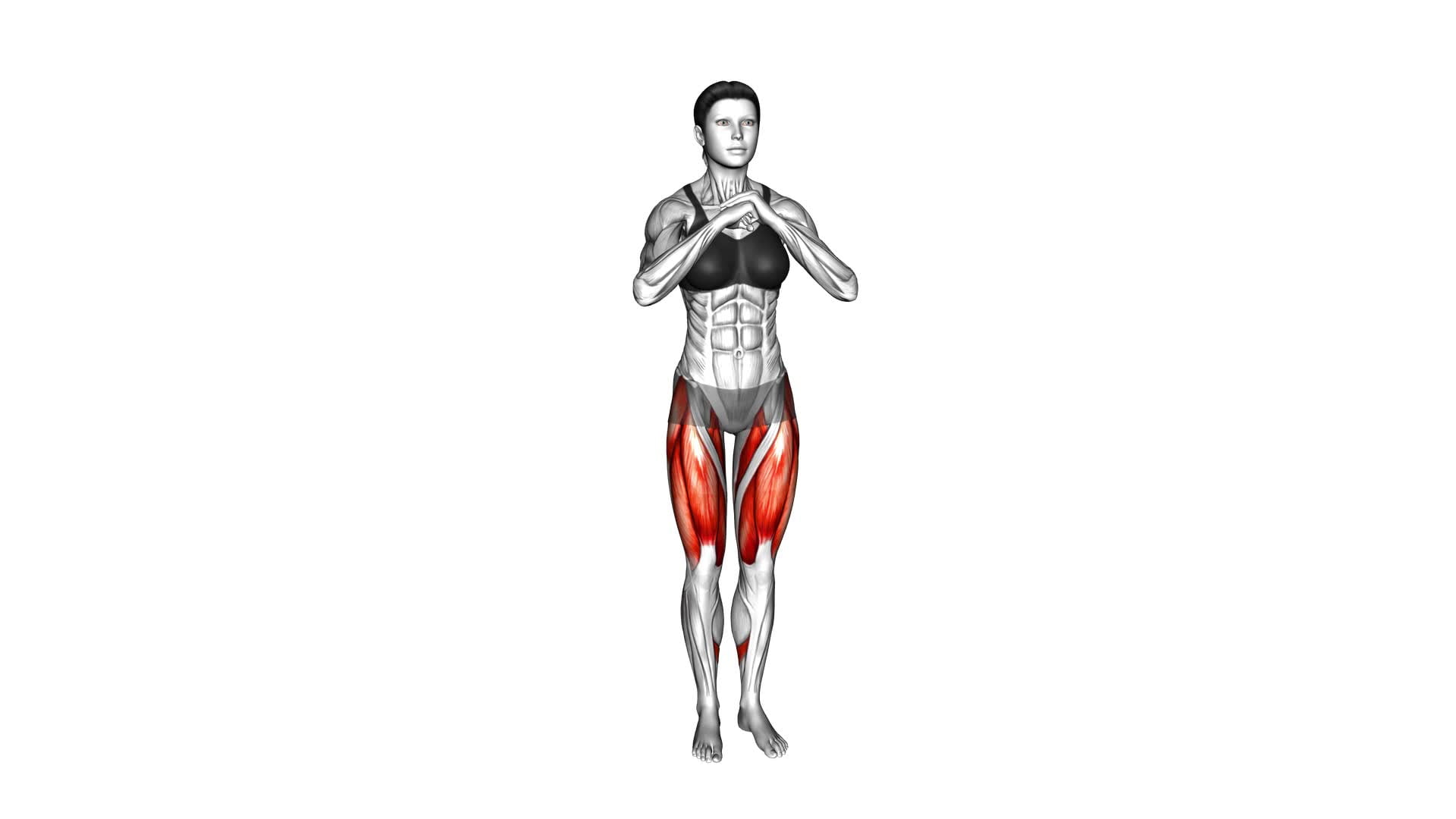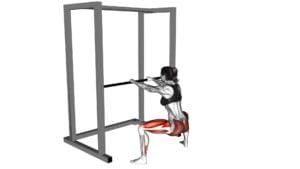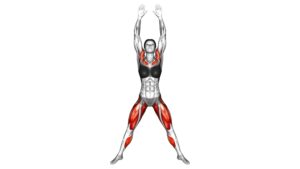Side Step Deep Squat (female) – Video Exercise Guide & Tips

Are you looking for a challenging lower body exercise that targets your glutes and quads? Look no further than the Side Step Deep Squat.
Watch This Exercise Video
In this video exercise guide, we'll show you the proper form and technique to perform this move effectively. Plus, we'll provide variations to keep you challenged and tips for incorporating it into your routine.
Get ready to sculpt and strengthen your lower body with this dynamic exercise.
Let's get started!
Key Takeaways
- Side Step Deep Squat improves flexibility and increases range of motion.
- It lengthens lower body muscles and tones and defines glutes.
- Maintaining proper form and technique is crucial, including engaging core muscles and keeping knees aligned with toes.
- There are variations to challenge yourself, such as adding weights, performing on an unstable surface, or engaging fast-twitch muscle fibers.
Benefits of the Side Step Deep Squat
You will experience a range of benefits when incorporating the Side Step Deep Squat into your exercise routine. This exercise is highly effective in improving flexibility and strengthening your glutes. By performing the Side Step Deep Squat regularly, you can expect to see noticeable improvements in your range of motion and overall flexibility. This is because the deep squat position stretches and lengthens the muscles in your lower body, helping to increase your overall flexibility.
Additionally, the Side Step Deep Squat specifically targets and strengthens your glutes. As you lower yourself into the squat position and then rise back up, your glute muscles are activated and engaged. Over time, this exercise can help to tone and strengthen your glutes, giving you a firmer and more well-defined posterior.
Incorporating the Side Step Deep Squat into your exercise routine is a great way to improve your flexibility and strengthen your glutes. However, it's important to perform this exercise with proper form and technique to avoid injury and maximize its benefits. By following the correct form and technique, you can ensure that you're targeting the right muscles and getting the most out of each repetition.
Proper Form and Technique
To ensure proper form and technique while performing the Side Step Deep Squat, focus on maintaining a stable stance and engaging your core throughout the exercise. This will help you prevent common mistakes and maximize the effectiveness of the workout.
One common mistake to avoid is allowing your knees to cave inwards during the squat. This puts unnecessary stress on your knee joints and can lead to injury. Instead, make sure to keep your knees aligned with your toes throughout the movement.
Another mistake to watch out for is rounding your back. This not only reduces the effectiveness of the exercise but also increases the risk of straining your lower back. Keep your back straight and your chest lifted as you lower into the squat.
The Side Step Deep Squat primarily targets the glutes, quadriceps, and hamstrings. By engaging these muscle groups, you can improve lower body strength and stability. Additionally, the exercise also activates the core muscles, helping to improve overall balance and posture.
Variations to Challenge Yourself
To increase the difficulty of the Side Step Deep Squat, try incorporating challenging modifications and advanced variations more frequently into your workout routine. These variations won't only make your workouts more challenging, but they'll also help you build strength, improve balance, and increase flexibility.
One challenging modification you can try is the weighted Side Step Deep Squat. Holding a dumbbell or kettlebell in each hand, perform the squat as usual, but with the added resistance. This will increase the load on your muscles, making the exercise more challenging.
Another advanced variation is the explosive Side Step Deep Squat. Instead of performing the squat at a slow and controlled pace, explode upwards as you come out of the squat, jumping off the ground and extending your arms overhead. This plyometric variation will engage your fast-twitch muscle fibers and improve your power and explosiveness.
You can also try performing the Side Step Deep Squat on an unstable surface, such as a Bosu ball or a foam pad. This will challenge your balance and core stability, as your muscles work harder to maintain stability during the exercise.
Incorporating these challenging modifications and advanced variations into your Side Step Deep Squat routine won't only keep your workouts interesting, but they'll also help you progress and achieve your fitness goals more effectively.
Tips for Incorporating This Exercise Into Your Routine
To effectively incorporate this exercise into your routine, regularly perform the side step deep squat with proper form and use a variety of challenging modifications and advanced variations. As you become more comfortable with the basic movement, you can progress in difficulty by adding weights such as dumbbells or kettlebells. Holding the weights at your sides or at shoulder level will increase the resistance and intensify the workout for your lower body muscles.
Additionally, you can try performing the side step deep squat on an unstable surface, such as a Bosu ball or a balance board, to engage your core muscles and improve your balance.
To create a full lower body workout, you can combine the side step deep squat with other exercises that target different muscle groups. For example, you can alternate between sets of side step deep squats and exercises like lunges, step-ups, or glute bridges. This will challenge your lower body muscles from different angles and provide a well-rounded workout.
In the next section, we'll discuss precautions and modifications for beginners to ensure proper technique and reduce the risk of injury.
Precautions and Modifications for Beginners
As a beginner, it's important to take precautions and make modifications to ensure proper technique and minimize the risk of injury when performing the side step deep squat. Here are some precautions and modifications you can follow:
- Start with proper warm-up: Before performing the side step deep squat, warm up your muscles with light cardio exercises like jogging or jumping jacks. This will increase blood flow to your muscles and prepare them for the workout.
- Focus on form: Pay attention to your form during the exercise. Keep your back straight, chest up, and knees aligned with your toes. Engage your core muscles to maintain stability.
- Start with shallow squats: If you're new to squats, begin with shallow squats instead of going deep. This will help you build strength and improve your technique gradually.
- Use a chair for support: If you find it challenging to maintain balance, use a chair for support. Hold onto the chair while performing the side step deep squat to ensure stability.
- Listen to your body: If you experience pain or discomfort during the exercise, stop immediately. It's important to listen to your body and avoid pushing yourself too hard.
Frequently Asked Questions
How Many Calories Does the Side Step Deep Squat Burn?
During the side step deep squat, you can burn a significant amount of calories. The exact number of calories burned will depend on various factors such as your weight, intensity, and duration.
Squatting engages multiple muscle groups, which can increase your calorie burn. To maximize the calorie burn, you should aim for longer squat durations and maintain proper form.
Consult with a fitness professional for personalized advice on calorie burn and squatting techniques.
Can the Side Step Deep Squat Help With Weight Loss?
The side step deep squat is a highly effective exercise for weight loss. By incorporating this move into your fitness routine, you can burn calories and shed unwanted pounds. This exercise targets multiple muscle groups, increasing your overall fitness level.
The side step deep squat also offers various modifications to accommodate different fitness levels and abilities. It's a versatile exercise that can be easily incorporated into any workout routine, making it a valuable tool for achieving your weight loss goals.
How Long Should I Hold the Squat Position During the Side Step Deep Squat?
When performing the side step deep squat, it's important to focus on your squat form and maintain proper technique.
As for how long you should hold the squat position, it's recommended to hold it for a few seconds before moving to the next step. This helps to engage your muscles and increase the benefits of the deep squat.
Remember to listen to your body and adjust the duration based on your fitness level and comfort.
Can the Side Step Deep Squat Help Improve Flexibility?
The side step deep squat can definitely help improve your flexibility.
By incorporating this exercise into your routine, you'll be working on improving your mobility and increasing the range of motion in your hips, knees, and ankles.
Deep squatting has numerous benefits, such as strengthening your lower body muscles and improving your overall stability.
Is It Normal to Feel Sore After Doing the Side Step Deep Squat?
Feeling sore after doing the side step deep squat is normal. It's a sign that your muscles are working and adapting to the exercise.
To minimize muscle soreness, make sure you're using proper form. Keep your knees aligned with your toes and engage your core throughout the movement.
Gradually increase the intensity and duration of the exercise to allow your muscles to gradually adjust.
Remember to listen to your body and rest if needed.
Conclusion
Incorporating the side step deep squat into your exercise routine can offer numerous benefits. This exercise is great for strengthening your legs, glutes, and core. It engages multiple muscle groups at once, making it an efficient and effective workout option.
To perform the side step deep squat correctly, start with your feet shoulder-width apart. Take a wide step to the side with one foot, keeping your toes pointed forward. Lower your body down into a deep squat, keeping your knees in line with your toes. Push through your heels to return to the starting position, then repeat on the other side.
To maximize the effectiveness of this exercise, it's important to follow proper form and technique. Keep your back straight and your chest lifted throughout the movement. Make sure your knees stay in line with your toes and don't let them collapse inward.
If you want to challenge yourself, try adding weights to the exercise. You can hold a dumbbell or kettlebell in front of your chest or use a resistance band around your thighs to increase the intensity. Another option is to increase the range of motion by lowering deeper into the squat or taking a wider step to the side.
As with any exercise, it's important to start slowly and listen to your body. If you're a beginner, you may need to make modifications to the exercise to suit your fitness level. You can start by performing the side step deep squat without added weights, and gradually increase the difficulty as you get stronger.
By including the side step deep squat in your workout routine, you can enhance your overall strength and fitness level. This exercise targets key muscle groups and can help improve your balance and stability. So give it a try and enjoy the benefits it has to offer.

Author
Years ago, the spark of my life’s passion ignited in my mind the moment I stepped into the local gym for the first time. The inaugural bead of perspiration, the initial endeavor, the very first surge of endorphins, and a sense of pride that washed over me post-workout marked the beginning of my deep-seated interest in strength sports, fitness, and sports nutrition. This very curiosity blossomed rapidly into a profound fascination, propelling me to earn a Master’s degree in Physical Education from the Academy of Physical Education in Krakow, followed by a Sports Manager diploma from the Jagiellonian University. My journey of growth led me to gain more specialized qualifications, such as being a certified personal trainer with a focus on sports dietetics, a lifeguard, and an instructor for wellness and corrective gymnastics. Theoretical knowledge paired seamlessly with practical experience, reinforcing my belief that the transformation of individuals under my guidance was also a reflection of my personal growth. This belief holds true even today. Each day, I strive to push the boundaries and explore new realms. These realms gently elevate me to greater heights. The unique combination of passion for my field and the continuous quest for growth fuels my drive to break new ground.







